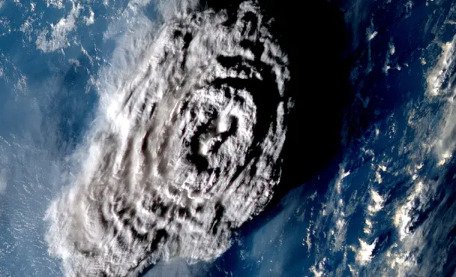According to geologists, a massive undersea volcanic eruption in Tonga last year had a magnitude similar to the US’s most powerful nuclear blast. Tonga volcano explosion equalled most powerful ever US nuclear test.
Scientists used eyewitness accounts, tide gauge data, satellite data, evidence of broken windows, and other sources to calculate that the Hunga Tonga-Hunga Ha’apai volcano eruption, which occurred on 15 January 2022 and was felt around the world, likely involved five blasts.
The final emitted energy was equivalent to around 15 megatons of TNT. That translates to almost 1,000 times the power of the Hiroshima bomb in 1945, putting the volcanic event on par with the most powerful nuclear weapon ever exploded by the United States: the Castle Bravo bomb detonated in Bikini Atoll in 1954.
The team, which is based in the United States and New Zealand, went on to say that the volcanic event, which occurred 65 kilometers (40 miles) from the country’s main island, included both eruptions which resulted in huge volcanic plumes being thrust into the stratosphere and explosions of steam, which caused sonic booms and were the main cause of the related tsunami.
Based on a mix of data sources, the researchers’ computer models of the event imply that the western shore of Tofua Island witnessed waves of up to 45 meters in height, a conclusion they claim is supported by traces of vegetation scars at the same altitude obtained by satellite and drone data.
People in Fiji, some 500 miles away, reported feeling the earth and buildings shake for hours as a result of the eruption. The Hunga Tonga-Hunga Ha’apai volcanic event is estimated to have killed six individuals, including four in Tonga and two in Peru who drowned as a result of abnormally massive waves induced by the volcanic activity.
According to the team, the colossal waves in sections of Tonga were expected to result in a higher death toll, however, this was not the case. Tonga volcano explosion equalled US nuclear test.
In the journal Science Advances, the team wrote that “The main factors that led to this, we suggest, are the quirk of the location, a worldwide pandemic, and increased evaluation drills and awareness efforts carried out in the years prior,” adding that “the main settlements in all of Tonga safely face Nuku’alofa Lagoon, the best possible scenario to duck the full brunt of a mega-tsunami.”
Tofua, an island in Tonga, is desolate, while other locations hit by strong waves were lightly populated, with tourist resorts shuttered due to Covid. Additionally, other populated islands are located on a carbonate platform where shallow seas help to keep the waves at bay.
The latest study builds on previous research that found the Tonga volcano eruption had the largest plume ever recorded, with an ash cloud reaching 57km (35 miles) in height.
